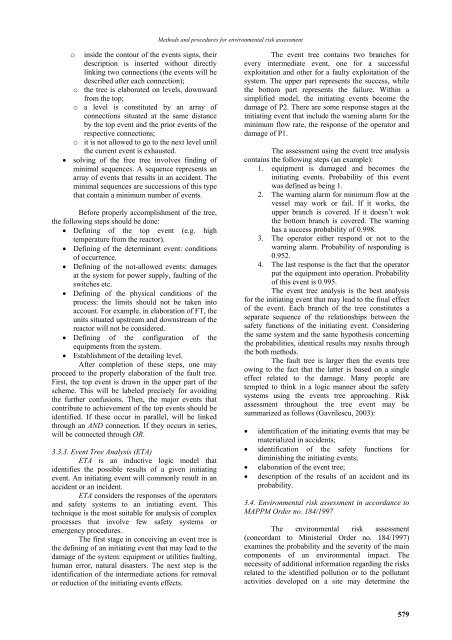2007_6_Nr6_EEMJ
You also want an ePaper? Increase the reach of your titles
YUMPU automatically turns print PDFs into web optimized ePapers that Google loves.
Methods and procedures for environmental risk assessment<br />
o inside the contour of the events signs, their<br />
description is inserted without directly<br />
linking two connections (the events will be<br />
described after each connection);<br />
o the tree is elaborated on levels, downward<br />
from the top;<br />
o a level is constituted by an array of<br />
connections situated at the same distance<br />
by the top event and the prior events of the<br />
respective connections;<br />
o it is not allowed to go to the next level until<br />
the current event is exhausted.<br />
• solving of the free tree involves finding of<br />
minimal sequences. A sequence represents an<br />
array of events that results in an accident. The<br />
minimal sequences are successions of this type<br />
that contain a minimum number of events.<br />
Before properly accomplishment of the tree,<br />
the following steps should be done:<br />
• Defining of the top event (e.g. high<br />
temperature from the reactor).<br />
• Defining of the determinant event: conditions<br />
of occurrence.<br />
• Defining of the not-allowed events: damages<br />
at the system for power supply, faulting of the<br />
switches etc.<br />
• Defining of the physical conditions of the<br />
process: the limits should not be taken into<br />
account. For example, in elaboration of FT, the<br />
units situated upstream and downstream of the<br />
reactor will not be considered.<br />
• Defining of the configuration of the<br />
equipments from the system.<br />
• Establishment of the detailing level.<br />
After completion of these steps, one may<br />
proceed to the properly elaboration of the fault tree.<br />
First, the top event is drawn in the upper part of the<br />
scheme. This will be labeled precisely for avoiding<br />
the further confusions. Then, the major events that<br />
contribute to achievement of the top events should be<br />
identified. If these occur in parallel, will be linked<br />
through an AND connection. If they occurs in series,<br />
will be connected through OR.<br />
3.3.3. Event Tree Analysis (ETA)<br />
ETA is an inductive logic model that<br />
identifies the possible results of a given initiating<br />
event. An initiating event will commonly result in an<br />
accident or an incident.<br />
ETA considers the responses of the operators<br />
and safety systems to an initiating event. This<br />
technique is the most suitable for analysis of complex<br />
processes that involve few safety systems or<br />
emergency procedures.<br />
The first stage in conceiving an event tree is<br />
the defining of an initiating event that may lead to the<br />
damage of the system: equipment or utilities faulting,<br />
human error, natural disasters. The next step is the<br />
identification of the intermediate actions for removal<br />
or reduction of the initiating events effects.<br />
The event tree contains two branches for<br />
every intermediate event, one for a successful<br />
exploitation and other for a faulty exploitation of the<br />
system. The upper part represents the success, while<br />
the bottom part represents the failure. Within a<br />
simplified model, the initiating events become the<br />
damage of P2. There are some response stages at the<br />
initiating event that include the warning alarm for the<br />
minimum flow rate, the response of the operator and<br />
damage of P1.<br />
The assessment using the event tree analysis<br />
contains the following steps (an example):<br />
1. equipment is damaged and becomes the<br />
initiating events. Probability of this event<br />
was defined as being 1.<br />
2. The warning alarm for minimum flow at the<br />
vessel may work or fail. If it works, the<br />
upper branch is covered. If it doesn’t wok<br />
the bottom branch is covered. The warning<br />
has a success probability of 0.998.<br />
3. The operator either respond or not to the<br />
warning alarm. Probability of responding is<br />
0.952.<br />
4. The last response is the fact that the operator<br />
put the equipment into operation. Probability<br />
of this event is 0.995.<br />
The event tree analysis is the best analysis<br />
for the initiating event that may lead to the final effect<br />
of the event. Each branch of the tree constitutes a<br />
separate sequence of the relationships between the<br />
safety functions of the initiating event. Considering<br />
the same system and the same hypothesis concerning<br />
the probabilities, identical results may results through<br />
the both methods.<br />
The fault tree is larger then the events tree<br />
owing to the fact that the latter is based on a single<br />
effect related to the damage. Many people are<br />
tempted to think in a logic manner about the safety<br />
systems using the events tree approaching. Risk<br />
assessment throughout the tree event may be<br />
summarized as follows (Gavrilescu, 2003):<br />
• identification of the initiating events that may be<br />
materialized in accidents;<br />
• identification of the safety functions for<br />
diminishing the initiating events;<br />
• elaboration of the event tree;<br />
• description of the results of an accident and its<br />
probability.<br />
3.4. Environmental risk assessment in accordance to<br />
MAPPM Order no. 184/1997<br />
The environmental risk assessment<br />
(concordant to Ministerial Order no. 184/1997)<br />
examines the probability and the severity of the main<br />
components of an environmental impact. The<br />
necessity of additional information regarding the risks<br />
related to the identified pollution or to the pollutant<br />
activities developed on a site may determine the<br />
579


